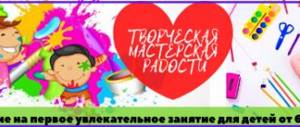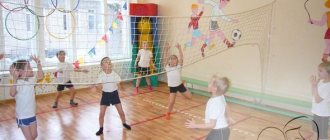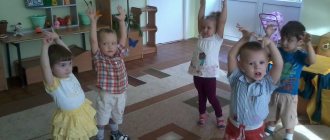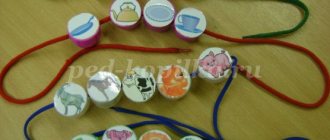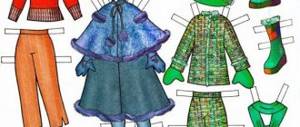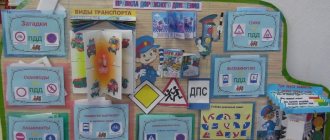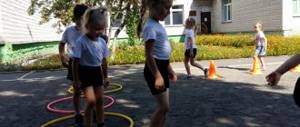MAGAZINE Preschooler.RF
Algorithm for learning the song “What is joy?” words by V. Medvedeva, music by L. Shakhova, with children of senior preschool ageState budgetary educational institution secondary school No. 684 “Bereginya” of the Moskovsky district of St. Petersburg
Musical director of the first qualification category Koroleva N. G. St. Petersburg 2016
Goals:
- Encourage children to want to sing
- Form, develop and consolidate singing skills in children.
The main tasks during the lessons are as follows:
- Teach children to perform songs with the help of a music director and independently, accompanied by an instrument, in and outside of class.
- Arouse interest in learning new songs (using the example of the song “What is Joy?” The name speaks for itself, this song is very bright, cheerful and energetic. There should be joy in everything, especially in music classes). Expand children's musical experiences. Creating a positive emotional mood is the main task of a teacher.
- To develop singing skills in children, skills that contribute to expressive performance (the work pays special attention to correct sound production, breathing, clarity of diction, and purity of intonation).
- Develop the voice, forming a natural childish sound, strengthening and expanding the singing range (in this song it is quite large - a major seventh).
- To develop an ear for music in the process of singing a song, through singing a melody with different pitches of sounds and their durations (mostly small even durations - eighth notes), the direction of movement of the melody (in which there is both a progressive downward movement, ascending and descending movements along the tonic triad) . Combine singing and rhythmic accompaniment of natural diaphones.
- To help children express their creative abilities through the emotional and figurative transmission of the song text.
Technologies used:
- Health saving technology
- Personally-oriented technology
- Communication technology
Singing is the most important means of musical education and plays a significant role in solving the problems of the comprehensive and harmonious development of the child.
The teacher should interest the content of the song - both its literary text and musical design, and evoke a desire to sing it.
The learning process, in turn, has several stages: the initial familiarization of children with the song and subsequent learning, when the main work on teaching singing skills is carried out.
The first acquaintance with the song should be based on a bright, imaginative, expressive performance by the teacher in order to excite the children and captivate them.
Of particular importance are clear articulation, facial expressions and conductor's gesture when the leader demonstrates musical material.
The first stage - getting to know the song (lesson 1)
Introduction:
Conversation before the song: read the poem by I. P. Tokmakova “Joy” .
Joy is if the sun is shining, If there is a month in the sky. How much joy in the world cannot be measured or counted.
Only the joyful ones hear the song of the wind from above, how the grass breathes quietly, how the flowers ring in the meadows.
Only the one who loves deeply, Believes in a bright dream, Will not spoil or destroy the beauty in this world.
A story about the content of the song - that we can see and feel joy in everything that surrounds us (using quotes from it - this is not only natural phenomena “joy is a rainbow above the earth at its zenith, joy is the sun...” , these are living beings “... and birds in the heights” , and nature - “sea, forest and mountains, field and river” ). Explanation of unfamiliar words ( “at the zenith” - when the sun is directly overhead).
A story about who the author and composer of the song is. It is necessary that children have a clear understanding and understanding that the author writes a poetic text, and the composer writes music for it.
Display of demonstration material on the theme of the song (pictures, cartoons).
Creating a cheerful emotional mood corresponding to the nature of the work.
Hearing:
Expressive personal performance of a song by a music director accompanied by piano.
Conversation about the song:
Find out the children’s attitude to the song (whether they liked it or not and why), determine the children’s understanding of the content of the song. Conversation about the nature of the work (cheerful, joyful, sunny).
The main stage is learning a song (2nd, 3rd, 4th, 5th lessons)
Preparation of the vocal apparatus:
- Breathing exercises (inflate a balloon, blow on a candle, breathe like dogs)
- Articulation gymnastics (facial exercise - lips are stretched out like a duck , we pronounce the sound “u” , we stretch our lips wide into a smile - “and” ; we draw a circle, a square with our lips, the tongue “runs” over the teeth and behind the teeth, stretch the tongue to the chin and release etc.)
- Tongue twisters and chants (singing chants with text in semitones). To tune in to this song, it’s good to start by singing tongue twisters on one sound (since the song has a lot of consonants “R” that need to be pronounced well) “Andrey Sparrow, don’t chase the pigeons” , they can be sung with different intonations: angrily, affectionately. For the cantilena sound and for the chant in the required range, sing the step-by-step chant “there is grass in the yard” (at a slow tempo. C – D – E – D – C).
Learning a song:
- Learning the poetic part of the song (with good articulation, even exaggerating a little) with the rhythmic pattern that the melody requires.
- Separate clapping of the rhythmic pattern along with the text (both in simple and complex places). Showing illustrations - hints on the theme of the song (in the text sequence - rainbow, sun, birds; for the second verse - a picture of a family, etc.). activation of the child’s personal experience (children’s story about what they saw themselves - what rainbow, forest, sea, etc.).
Pay special attention to words that end with a consonant (for example, “give” , “radiate” ) so that this letter is not “eaten” , but is sung with increased attention. Also difficult is the ending of words ending with vowels. This requires some work.
- Mastering melody: musical echo (music director - children). You need to start learning a melody in phrases (first you can sing in a convenient syllable, for example “LA” ). In the process of learning, use syllabic formulas, for example, slogori (where “ti” is eighth notes, “ta” is quarter notes). It is obligatory for the music director to demonstrate pitch and rhythm by hand. Sing difficult melodic passages separately at a slow tempo.
- Singing with vocal groups of different composition:
- in rows
- boys separately
- girls separately
- singing with soloists.
Humming:
- Expressive performance of the song by the music director as an example.
- Show children where to sing louder or quieter and explain why. Tell where the chorus is and explain what needs to be done at this time (during the chorus, in the pauses between “la-la-la you need to have time to do three claps”) .
- Formation of high-quality sound of a song from beginning to end. Pay attention to breathing, phrasing of the song, and the simultaneous beginning and ending of the song.
- Create an emotional mood for the performance of the song.
- It is necessary that when performing a song, children do not forget about the correct singing position (back straight, arms freely lowered along the body, legs slightly apart - slightly narrower than shoulder width).
The final stage is singing a song (6th lesson)
Expressive performance of a song in front of an audience at a festival.
Activating the interaction between parents and children through inclusion in the overall sound of the song (joint performance of the chorus by parents and children).
Learning a song does not end with its concert performance. Work continues through:
- Listening to audio recordings of this song (performed by other children).
- Recognition of songs by children by melody, intro, textures and rhythmic pattern.
- Assessment of children by children.
- Learning new songs.
| Next > |
Methods of learning songs with preschool children
Methods of learning songs with preschool children.
It is necessary to start working on learning a song from the preparatory stage. Which involves familiarization and analysis of the song, identification of artistic value, educational tasks, technical difficulties, and identification of methodological techniques to overcome them.
Singing abilities vary in each age group. Until the age of 3, children accumulate experience in perceiving music, sensory-auditory and rhythmic concepts, and intonating a melody with their voice. From 3 to 5 years, coordination of hearing and voice, music and movements, and the combination of knowledge and skills occurs. From 5 to 6 years of age, practical actions are supported by knowledge about music, enriched by it, and elements of an aesthetic attitude towards singing and music in general are formed.
In classes with the youngest children, chants and small songs of an imitative nature are used (voices of birds, animals, sounds of the surrounding reality, repeated intonations); it is desirable that the text contains the sounds zh, h, shch.
melodies should be simple, built on 2-4 sounds in the range: re1-sol1.
In children 3-4 years old, the range is: re1-la1, breathing is not yet uniform, short, not everyone has developed articulation and diction. At 4-5 years old, the range expands: re1-si1, breathing is more stable, phrases are drawn out, words are pronounced better. At 5-6 years old the range is from C(re)1 octave to C(re)2 octave. Children have better control of singing breathing and can sing phrases of up to 2 measures at a slow tempo. A more varied repertoire is used, at any tempo and any dynamics.
The work can be roughly divided into three stages.
Stage 1. Emergence of an impression of the song (1-2 lessons).
Introduce children to the song, create emotional interest in its image, reveal the content of the song.
Conversation on the content of the song, viewing a toy or drawing. The title of the song is given and then performed expressively. If the text is difficult to understand, then you need to read it and explain the meaning of unclear words. To give a complete artistic image, the song is performed several times.
2. Stage. Learning a song (3-5 lessons).
— first, the song is taught without musical accompaniment (with an adult’s voice and playing along with the melody), so that children better learn intervalics;
- singing without and with music;
- heavy melodic and rhythmic moves need to be taught separately (children listen to an adult sing and then repeat after him);
- the text must be studied with the melody;
— an individual approach is widely used: children sing together, and then take turns: boys and girls, sitting and standing.
3. Stage. Reinforcing the learned song (from lesson 6).
Work on recreating the musical image of the song, on emotional and expressive performance.
— repetition of songs from the repertoire of one’s own or a previous group in a different key;
- work on the expressiveness of performance (tempo, dynamics, character, singing with soloists, using children's musical instruments);
- performance accompanied by movements, playing musical instruments, staging songs.
QUESTIONS
1. The importance of singing activity in musical and personal development
preschooler.
2. Goals and objectives of children’s singing activities.
3. Age characteristics of the development of voice and hearing in preschool children. Oh at the child's voice.
4. Types of singing activities for children. Characteristics of the repertoire
5. Contents of vocal and choral education in kindergarten.
6. Stages of teaching children to sing. Specifics of teaching methods at each stage of song learning.
LITERATURE
1. Brygina G. Russian folk song as a means of teaching expressive singing // Doshk. upbringing. - 1980. - No. 7. - P. 87.
2. Vetlugina N.A., Keneman A.V. Theory and methods of music education in kindergarten. - M., 1983. - P. 147-157.
3. Vetlugina N.A. Musical ABC book. - M., 1989.
4. Voinova A.D. Development of purity of intonation in the singing of preschool children. - M., 1960. Metlov N.A. Music for children. - M., 1985. - P. 18-50.
5. Methods of music education in kindergarten / Ed. N. Vetlugina. - M., 1989.-S. 76-89.
6. Rada nova O.P. and others. Musical education of preschool children. - M., 1998. - P. 93-98.
7. Stulova G.P. Development of a child's voice in the process of learning to sing. - M., 1992. - P. 111-119, 147 -151, 170-174.
8. Teach children to sing: Songs and exercises for voice development in children 3-5 years old / Comp. T.M. Orlova, S.I. Bekina. - M., 1986.
9. Teach children to sing: Songs and exercises for voice development in children 5-6 years old / Comp. T.M. Orlova, S.I. Bekina. - M., 1987.
Game techniques in singing preschoolers in music classes
Arzhint Larisa
Game techniques in singing preschoolers in music classes
The purpose of the chants is to prepare the vocal cords for singing and to exercise pure intonation at certain intervals.
Tasks:
— develop diction, articulation and breathing in singing, prevent diseases of the upper respiratory tract; strengthen children's fragile vocal cords;
— develop children’s creative abilities, develop theater skills;
- develop the ability to correctly select the pitch of the voice in connection with voicing familiar characters, i.e. pure intonation.
The development of vocal and choral skills in preschool children is an important and complex task that requires a system of work that includes a variety of play methods and techniques for developing the child’s voice.
I use play chants in music classes in various activities of preschoolers: this includes musical greetings, valeological chants, and elementary music playing, as well as breathing and articulation gymnastics, speech games in the form of musical phrasing, phonopedic exercises, and melodized finger games. Children should begin preparing for singing from the earliest preschool age. For kids who have a very small vocabulary, this is a simple onomatopoeia of someone: the singing of a cockerel or a bird; the meowing of a cat or the barking of a dog; the hum of a car or train, etc. These exercises are carried out, as a rule, in a high and low register within an octave and help the development of pitch hearing in children, for example, the game “Birds”
or the game “Ladder” based on the fairy tale by V. Shein.
Fairy tale “Ladder”, author V. Shein
In one village there lived some cheerful friends. Every evening they gathered on the stairs. The Little Frog sat on the bottom step and sang his song: “Kwa-kwa!” (children sing re1) A cheerful Puppy sat on the second step and joyfully barked: “Woof-woof!” (children sing mi1). A fluffy Kitten climbed onto the third and meowed affectionately: “Meow-meow! (children sing F#). The fourth step was chosen by the vociferous Cockerel, who sang: “Ku-ka-re-ku!” (children sing salt1) And Sparrow sat on the highest step, because he had the thinnest and most sonorous voice, and he sang high: “Tweet-chirp!” (children sing la1) So they sat every evening and sang. They came up with a song like this. Everyone sings a song.
At an older age, you can use simple chant songs. Simple texts and melodies, consisting of sounds of the major scale, lift your spirits, set a positive tone for the perception of the world around you, improve the emotional climate and prepare your voice for singing. These are not only chants on one sound “Andrew the Sparrow”, but also ascending and descending singing, for example: “Kolobok” of the muses. A. Evtodieva. By using this chant to prepare for singing, not only singing skills are developed, but also the artistic abilities of children. I use a mitten theater for this chant. The children, playing this or that role, independently change the pitch of their singing. And, of course, for chanting I always use chants for the seasons.
Valeological chants.
All music classes for children of senior preschool age begin with them. Simple texts lift your spirits, set a positive tone for the perception of the world around you, improve the emotional climate in class, and prepare your voice for singing.
For example, valeological chant songs: “It’s pleasant and comfortable to sing,” “Good afternoon!” author E.V. Kislitsina, “Hello!” M. Kartushina and others.
In older preschool age, chants are complicated by intervals and singing in the middle and high register, for example, chants according to the method of A. Evtodieva: “Kitten and Ladybug”, “Bee and Little Bear”, “Squirrels”, “Fox and Birdie”, etc.
When learning a song, I often observe that many children pronounce certain sounds incorrectly. This indicates incomplete development of the muscles of the speech apparatus. Articulation gymnastics helps me cope with these difficulties, the purpose of which is to develop singing abilities, a sense of rhythm, improve diction, and form articulation of various sounds. I spend it in a playful and emotional way, for example, a game
"Ginger cat in winter"
1,2,3,4,5, let's go for a walk with Ryzhik (open your mouth wide and hold it for a few seconds)
1,2,3,4, we will open our mouth wider.
Chewed (chewing movements, knocked (knock teeth)
And they ran with the kitten (moving the tongue forward and backward)
Who caught snowflakes with his mouth, (catch snowflakes with his mouth)
He walked left and right. (moving tongue left-right)
Ryzhik is bored, guys! Let's play hide and seek with him.
(pull your lips into your mouth, then stick your tense, narrow tongue forward)
Ryzhik is tired of hiding, Ryzhik, uh, has become angry.
(bending upward, the tip of the tongue presses against the lower teeth)
We will pet the cat, show everything with our mouth (“comb”)
To teach children how to sing vowel sounds correctly, exercises where singing sounds are combined with movement according to the method of T.V. Lobanova are very similar.
In preparatory groups, I use chants to develop the muscles of the speech apparatus, as a result of which the development of children’s speech and singing skills increases. Folk songs and jokes are very convenient for singing: “Along the river”, “Brooms - brooms”, “And here, in the workshop”, “River”, etc. In my classes I use songs and games by L. A. Olifirova , for example: “Horse”, “Cuckoo”, “Titmouse”, “Goat”.
The children not only learn to sing intervals, but also develop their songwriting creativity. Children really like video chants for the seasons, “Pea”, “Autumn”, “Winter chants”, speech therapy songs.
Games with voice. Musical patterns.
Children really like to play with their voices, using graphic drawings according to the method of T. Tyutyunnikova. Each graphic has a name. After repeated use, children can independently play with their voices and identify this or that graphic pattern by ear, thereby training their musical ear and memory.
And T. Tyutyunnikova’s method is used in the “Relay Race” game, in which children improvise with their voices and develop long-term singing. As soon as children have mastered singing from musical drawings, you can invite them to draw their own musical pattern and try to sing it. This will be a good creative challenge in singing. The musical and didactic game “The Singing Caterpillar” is very suitable for singing.
The systematic use of chants helps to even out the sound of the voice and achieve natural, easy singing. It is important that each exercise has interesting content or a playful moment that can captivate the child. Each person at birth receives a unique gift - a voice, which, if desired and under favorable conditions, can become a musical instrument. Therefore, children should receive pleasure and joy from classes, from the very process of singing.
Rustle of Leaves
If a boy or girl of 3-4 or 5-6 years old attends a choir club, then sooner or later they will have to sing using a microphone.
To teach children to listen to their voice when it is amplified by this device, the following songs were created:
- “The wind rustles in the leaves” - the children hiss “Sh-sh-sh-sh-sh”, first louder and then quieter. The second part of the exercise is when the child’s voice remains constant, and the baby moves the microphone closer and further from the mouth, adjusting the volume of the sound.
- “Wolves howl at the moon” - children sing the sound “Ooo-oo-oo-oo-oo”, moving their voice up and down the scale. The chanting to re mi can be used with this sound.
Chants. Joke joke for kids


